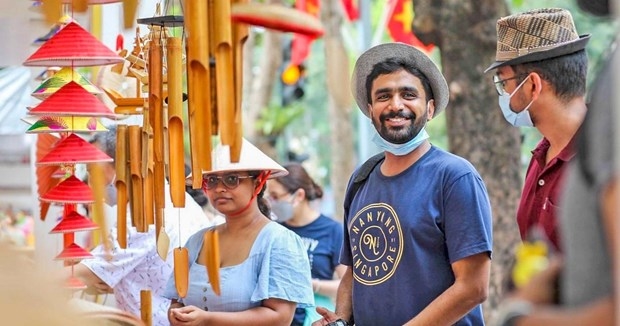 |
| The new e-visa policy facilitates group and MICE tours. (Photo: VNA) |
Under the policy, Vietnam has extended the validity of tourist e-visas to 90 from 30 days, with multiple entries, and tripled the duration of visa-free stays for visitors from certain countries to 45 days.
Ha Linh, who helps customers with tour booking in Ho Chi Minh City, said the policy has facilitated the organisation of group tours by travel firms, as well as tour booking and information access by clients.
Sharing Linh’s view, Thanh Dat, a tour guide in the same city, said since the new policy came into force, the number of group tours to Vietnam has increased significantly. He said the new visa policy helps the Vietnamese tourism sector to catch up with their peers in the region and the world, opening up more cooperation opportunities for them.
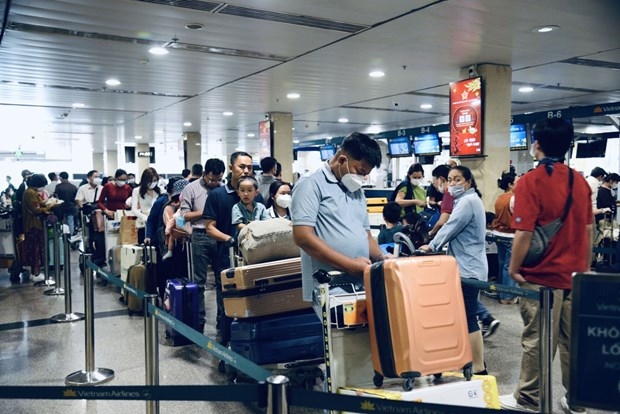 |
| The new visa policy helps the Vietnamese tourism sector to catch up with their peers in the region and the world. (Photo: VNA) |
Chung Thuy Chau, Sales Director of Viet Media Travel Corporation, expressed her belief that the policy will help to attract more holidaymakers, especially in the remaining months of this year. She added that it also creates favourable conditions for travel agencies to cooperate with partners in both outbound and inbound tours.
Notably, the Japanese Embassy in Hanoi and Consulate General in HCM City have recently announced single-entry e-visas for groups of Vietnamese tourists for short-term stays of up to 15 days from November.
The e-visa will not be available for individual applicants. It is done through travel companies that are approved to organise package tours, the embassy said on its website.
Tour operator Saigontourist also reported a 10% year-on-year increase in MICE services at home in the third quarter of this year. In HCM City alone, it organised inbound tours for 230 groups with more than 16,750 vacationers, and outbound tours for 48 others with over 4,800 tourists.
The company is expected to launch outbound tours for 143 groups with 21,755 members in the remaining months, mainly to the Republic of Korea, Thailand, Malaysia, Beijing and Shanghai (China), Australia, New Zealand, the US, the UK and Spain.
Outlook Traveler suggests must-visit beaches in Vietnam
Travelers planning a trip to Vietnam in the near future should consider visiting one of the many beautiful beach destinations the vibrant country has to offer, VOV reported a recent article published by India's leading travel magazine Outlook Traveler.
Author Waquar Habib suggested some of the best places to enjoy Vietnamese sun, surf, and sand, including the UNESCO-listed Ha Long Bay, the sandy dunes of Mui Ne, and the island escapes of Con Dao and Phu Quoc.
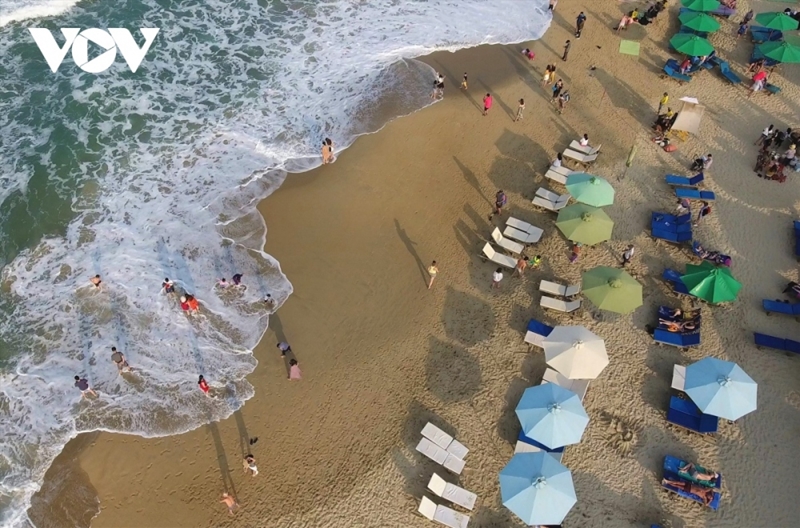 |
| The central region of Vietnam is home to many beautiful beach destinations. (Source: VOV) |
The Indian media outlet recommended that a day trip to Ha Long Bay, an awe-inspiring UNESCO World Heritage Site, is an absolute must for all visitors.
Ha Long Bay is renowned for its unique limestone formations, but also offers some stunning beaches. One of the most popular beaches is Bai Chay, which is artificial and attracts plenty tourists.
In order to get the whole experience, visitors are advised to take a boat tour to Ti Top Island in the middle of the bay, where travelers can find a lovely beach.
Con Dao which comprises 16 islands in southern Vietnam is another good choice for trips around the country. Con Son, the main island of the Con Dao archipelago, is blessed with wonderful beaches, turquoise water, and rich coral reefs. It has also been declared as a National Park.
The third beautiful beach destination in Vietnam is Phu Quoc. Khem Beach, also known as "Cream Beach", is one of the world's finest at the southern tip of the island. Similarly, Sao Beach is located nearby and offers palm-fringed shores, white sand, and breathtaking views.
The article also shared that Doc Let is a beautiful bay situated just an hour from Nha Trang City. The area is a hidden gem with its environs unexplored and pristine that boasts around 11 miles of white sandy beaches and crystal-clear blue water.
Elsewhere on the list is Da Nang, a beautiful coastal city. Travellers here can look forward to many water sports like surfing, snorkeling, and jet-skiing. Guests can also explore the Tien Sa Beach on a motorbike to the north of the Son Tra Peninsula.
Another hidden gem is Ho Coc, a coastal region famous for its quiet and clean Ho Coc Beach. Located north of Ho Tram in Ba Ria-Vung Tau province, this beach is nestled in a bay surrounded by forests and dunes.
The final destination on the list is Hoi An which is a historically rich city in central Vietnam, which dates back to the 15th century. It is famous for its well-preserved architectural heritage reflecting French, Chinese, and Japanese cultures.
Moreover, the UNESCO-listed Ancient Town is also a site boasting beautiful beaches, including Cua Dai Beach which is known as a serene escape.
The hidden gem is the Cham Islands, a cluster of eight pristine islands along the coast. UNESCO recognises these islands as a biosphere reserve. These islands boast a wide variety of plants and marine life, with over 200 fish species, making them a paradise for both beach lovers and nature enthusiasts.
Northwestern provinces look to turn terraced fields into cultural assets
Terraced fields and the culture linked with them are considered a “specialty” of the northwestern region, but comprehensive investment strategies and development measures are needed to fully capitalise on this tourism resource, experts said.
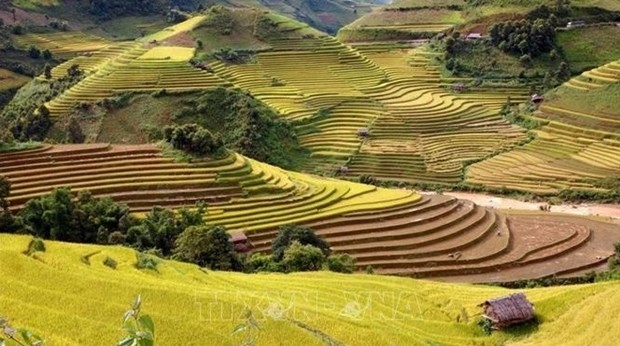 |
| The northwestern region is home to the largest number of and most beautiful terraced fields in Vietnam. (Photo: VNA) |
The northwest is home to the largest number of, and most beautiful terraced fields in Vietnam, mainly in Yen Bai, Ha Giang, and Lao Cai provinces. Notably, the nearly 2,200ha in Mu Cang Chai district of Yen Bai, 765ha in Hoang Su Phi district of Ha Giang, and another 1,000ha in Sa Pa town of Lao Cai were recognised as national-level landscapes.
Not only a result of agricultural production in mountainous areas, terraced fields with impressive but also poetic beauty are also deeply imbued with cultural and historical values and a demonstration of the solidarity, creativity, and efforts to surmount harsh living conditions of local residents in the area.
In recent years, many localities have launched new tours and festivals of terraced fields, attracting visitors from far and wide. Community-based tourism has become popular in many places with terraced rice paddies such as La Pan Tan, Nam Khat and Cao Pha of Mu Cang Chai district, Nam Hong of Hoang Su Phi district, and Lao Chai, Ta Van and Ta Phin in Sa Pa township.
However, many experts pointed out that tourism products linked with terraced fields remain limited and haven’t been linked together to form inter-provincial products. Therefore, to optimise the tourism value of northwestern terraced fields, it is necessary to have comprehensive investment strategies and development measures.
Speaking at a recent workshop held in Ha Giang province, Assoc. Prof. and Dr Duong Van Sau from the Tourism Faculty of the Hanoi University of Culture said that tours are developed for the terraced fields mainly in the “white season” (the watering season in April - May) and the “yellow season” (the ripe rice season in September - October).
He recommended localities join hands with travel companies to open tours in the “green season” (when rice is about to produce ears, in July - August) and the “flower season” (when various plants blossom such as rapeseed and buckwheat, in December - March).
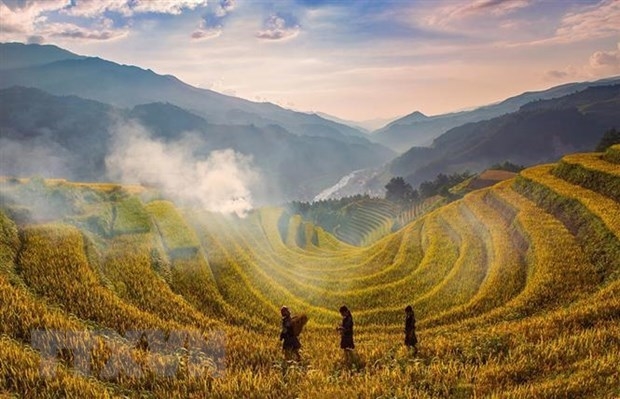 |
| Terraced fields in Mu Cang Chai district of Yen Bai province (Photo: VNA) |
Tours of terraced paddies have been limited to just giving travellers a place to take beautiful pictures, so it is necessary to diversify experiences for tourists, the expert pointed out.
Sau suggested planting glutinous rice varieties on terraced fields to offer specialties to visitors, farming fish there for tourists to try fishing and local fish delicacies, or building suitable rest areas so that tourists can enjoy and take photos of landscapes and buy local products.
Kenneth Wood, Director of the Swiss Tourism for Sustainable Development Project in Vietnam, said that it is necessary to have a general and comprehensive approach from planning to management at the provincial level.
He suggested provinces start with reviewing their general tourism development plans and building a cooperation model for state agencies, travel companies, and local communities. The cooperation should cover destination management, the development of natural and cultural environments connected with terraced fields, the creation of new products, brand building, and destination marketing.
Wood also pointed out the need to improve the tourism management and development capacity of communities as the ones who create, preserve, develop, and benefit from terraced fields to ensure sustainable development of the paddies.
For his part, Lai Quoc Tinh, Chairman of the Ha Giang provincial Tourism Association, noted terraced field tourism is typical for the localities home to steep earthen mountains, so connectivity among the regional provinces should be boosted to link their travel services, tours, and businesses to create unique products, thereby enriching experiences for visitors and promoting the value of terraced fields as a tourism resource in the northwest./.